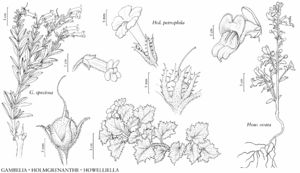Holmgrenanthe
Syst. Bot. Monogr. 5: 54, fig. 24. 1985.
| Taxon | Illustrator ⠉ | |
|---|---|---|
 | Gambelia speciosa Holmgrenanthe petrophila Howelliella ovata | Barbara Alongi Barbara Alongi Barbara Alongi |
Herbs, perennial; caudex woody. Stems erect, hairy. Leaves cauline, alternate; petiole present; blade not fleshy, leathery, margins spinulose. Inflorescences axillary, flowers solitary; bracts absent. Pedicels present; bracteoles absent. Flowers bisexual; sepals 5, distinct, lanceolate, calyx radially symmetric, urceolate; corolla pale-yellow, bilaterally symmetric, weakly bilabiate, tubular, tube base not spurred or gibbous, lobes 5, abaxial 3, adaxial 2; stamens 4, basally adnate to corolla, didynamous, filaments glandular-hairy; staminode 1, filamentous; ovary 1-locular, placentation axile; stigma conical. Fruits capsules, dehiscence loculicidal. Seeds 30–70, tan, polygonal-pyramidal, wings absent.
Discussion
Species 1.
Holmgrenanthe is defined by characteristics unique or uncommon in Antirrhineae: cespitose habit, leaves and sepals with spinulose margins, a one-locular ovary with a T-shaped septum, and foveolate, pyramidal seeds. Based on its morphological distinctness, Holmgrenanthe has been recognized as monotypic since its delimitation (D. A. Sutton 1988; E. Fischer 2004). In phylogenetic studies based on morphological data, H. petrophila is basal to other genera (M. Ghebrehiwet et al. 2000) or is part of an unresolved basal trichotomy among genera (W. J. Elisens 1985) within the Maurandya clade (Maurandyinae). Bayesian and maximum likelihood analyses of nuclear ITS data in Antirrhineae (M. Fernández-Mazuecos et al. 2013) placed Holmgrenanthe in a Cymbalaria clade comprising two subclades, one including Holmgrenanthe and six other genera in subtribe Maurandyinae and the other Asarina and Cymbalaria.
Selected References
None.